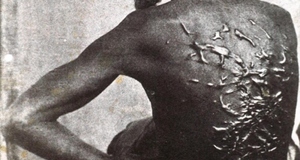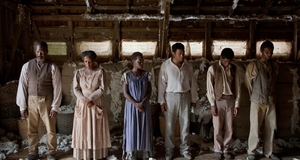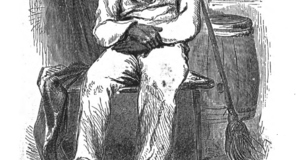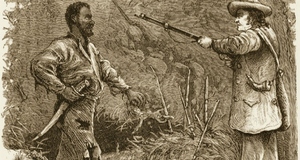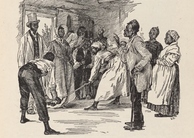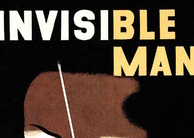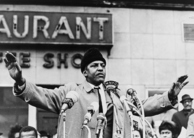Echoes of W.E.B. Du Bois' Double-Consciousness in the Narrative of the Life of Frederick Douglass
By
2019, Vol. 11 No. 04 | pg. 1/1 AbstractA close scrutiny through a text-based analysis of Frederick Douglass’ Narrative of the Life Of Frederick Douglass, an American Slave, Written by Himself (1845), would reveal, unquestionably, that this narrative reflects the condition of the African-American as cursed/endowed by double-consciousness as it is exactly announced by W.E.B. Du Bois in his The Souls of Black Folk (1903). By dint of a systematic recourse to oppositions, and especially the use of the literary device known as chiasmus, Narrative has succeeded in strikingly dramatizing the DuBoisian concept of double-consciousness. A detailed analysis through a text-based study of Frederick Douglass’ Narrative of the Life Of Frederick Douglass, An American Slave, Written by Himself (1845) will allow the reader to see the characteristics of double-consciousness dramatized in exactly the same way they would be delineated by Du Bois in The Souls of Black Folk (1903). Hence, this study of the Narrative with the aim of revealing all the aspects pertaining to double-consciousness would concentrate on the text as a closed system, putting aside all extraneous material so that the text, by itself, be considered a repository and a reflection of DuBoisian double-consciousness dramatized. And if Du Bois asserts in his famous saying that “the Negro is a sort of seventh son, born with a veil, and gifted with second-sight in this American world”1 (Souls, p. 7), making, thus, the emergence of double-consciousness simultaneous with the slave’s birth, Douglass’ Narrative ascertains that doubleness, surprisingly enough, precedes even birth and seems an ordinance to which the African-American is doomed even before his birth. This is completely true of Douglass’ experience. Before his birth, his destiny has already been weaved through doubleness, because he has been issued from an illegitimate sexual relationship between a black woman and a white man, as we read in the Narrative: My mother was named Harriet Bailey. She was the daughter of Isaac and Betsey Bailey, both colored, and quite dark... From the very outset, the reader is presented with an atmosphere invaded with doubleness, of which the narrator is not completely aware. The mother is opposed to the father as far as color and the social status are concerned, and the father has, by himself, two diametrically opposed roles in the narrative, being at the same time the father with all the affection that his status demands, and the master with the harshness that this second status has to embody. A consideration of the major aspects that constitute the Narrative will unequivocally demonstrate that their shared characteristic is doubleness. To begin with, the Narrative is made of the narrative proper, composed of eleven chapters and two white-authored prefaces, a preface by WM. LIoyd Garrison, and a letter by Wendell Phillips, Esq., plus an appendix by Douglass. And if the leisurely reader concentrates exclusively on the core of the Narrative, putting aside what comes before and after it, the studious researcher has to see the far-reaching implications of these extra-narrative elements, and, in our case, their bearing on the concept of double-consciousness. Structurally, both the preface, the letter - with their recommendatory tone -, and the appendix are frames that circumscribe the Narrative, situating it between the confines of these frames, to reflect the peculiar condition of the African-American who is always situated between two spheres. The Narrative as a voice of the subaltern is activated and almost validated only through the intervention of ‘two masters,’ two white authorities, who first prefaced the Narrative, namely W.M. LIoyd Garrison and Wendell Phillips, Esq. Douglass’ tale is enslaved, so to speak, by the authority of two white authors; it is an in-between tale. In fact, Douglass’ Narrative owes as much to its writer’s personal effort as to the two prefaces in the absence of which many important illuminations and implications about the narrative proper would have been missed. About the role of these prefaces and their bearing on the narrative proper, Robert Burns Stepto says,
It is an eclectic narrative form because it is the outcome of a hybrid environment that is far from being homogeneous. But while Stepto’s statement is unquestionably pertinent in underlining the authenticating role of these prefatory documents, the prefaces in Douglass’ Narrative are more than a way of recommending or authenticating Douglass’ voice. In addition to their function of setting the tone of the Narrative, they reflect, structurally, the real state of being of Douglass. As Douglass’ consciousness is absolutely conditioned by doubleness – an African and an American but not totally either– so is his Narrative, a mongrelized tale reflecting the true nature of his inner self. The Narrative would have always remained inevitably lacunary, had it not been completed by the two prefaces to show the white side related to Douglass. In this sense, the Narrative becomes, thus, purely African-American, in every sense of the oxymoron, by the intermingling of the white and black voices. The prefaces serve, also, as a liminal space, a threshold that introduces the reader to the tale proper, situating it between two spheres, filling, in this way, the void or unoccupied space that is the soil where essentialism and manicheanism are easily sown. In a word, the prefaces help create, as Homi Bhabha puts it, a situation reflecting “an expanded and ex-centric site of experience and empowerment.”4 It is a site which has always been marginalized through the complicity of the white man, and which is now laid bare by the subordinate. Also significant in the underlying of doubleness in the Narrative is the peculiar unfolding of the events that are themselves far from being unilateral or one-dimensional, but rather open to at least a double expectation. As a salient example, there is the death of Harriet Bailey, Frederick’s mother, which constitutes a concrete case of what Roman Jakobson calls “defeated anticipation,”5 or defeated expectancy, a device that reinforces the unnaturalness of the interactions between an act and its results. Within the plantations, this is seen in the way Douglass welcomes his mother’s death, commented upon in the Narrative by Douglass himself in the following terms: “I received the tidings of her death with much the same emotions I should have probably felt at the death of a stranger” (Narrative, p.17). Through the device of defeated expectancy, the reader is constantly thwarted in his expectations, because the outcome of many actions is the least expected, if not the opposite of what is expected in similar natural situations. This is due to the special aura invading the plantations and which creates doubleness that has become part and parcel of the African-Americans’ daily life. In the Narrative, every aspect seems to have been put forth to highlight the condition of African-Americans as inescapably doomed to double-consciousness. One can sense that there is in the Narrative a heavy reliance on geographical borders to reflect the doubleness that is a salient characteristic of the slaves in the plantations. It is true that one cannot deny the fact that many places could have remained unknown or at least not connected with the atrocities of slavery had they not been mentioned in Douglass’ Narrative; the reader, for example, encounters many places as early as the first lines of the Narrative in which we read, “I was born in Tuckahoe, near Hillsborough, and about twelve miles from Easton, in Talbot county, Maryland” (Narrative, p.15), references to areas with accurate precision that highlights the importance of space and lends authenticity to the tale. But in addition to their importance in lending authenticity to the tale, geographical locations in the Narrative play another important role in that they shed light on the nature of areas that have given, among other things, birth to the African-Americans’ peculiar feeling of double-consciousness. The mention of places in the Narrative, unlike in some other tales, does not have the usual aim of simply locating the action. Space in this Narrative conditions the behavior of the slaves, mainly. Thus, the slaves’ double-consciousness owes as much to the nature of the setting as to other aspects in the plantations, for these slaves have to act doubly within this specific context, depending on which area they happen to be in. In short, they have to alternate and adjust their behavior to space which is governed by strictly established norms, and to act through the revelation not only of the other, as Du Bois states, but also through the revelation of space itself, in perpetual change of their behavior to make it commensurate with each specific part of the plantations. Indeed, duality is, principally, manifested in this very space, for it is not a passive area that serves only to locate the characters’ actions, but it is an agent that acts upon the characters and, more often than not, determines their actions and being. Throughout the Narrative, the characters themselves identify with some spaces and feel repugnance towards others, sometimes in an unnatural manner in the sense that there is no unique or logical reasoning that determines the relation of the characters to their space. In the Narrative, the space is at times welcoming, but at others repelling; it is embracing but stifling, vast but restricted. Above all, it is stratified: the Great House Farm versus the slaves’ cabins, each location with its specificities. The space is not used in the traditional way of locating, spatially, the characters and the action. Rather, it is given agency; it governs, and often even determines the events. More often than not, the destiny of the characters is dependent upon the space. As an outstanding example we have Douglass’ move to Baltimore, and the insistence on the significant act of rubbing off his skin. “I spent the time in washing, not so much because I wished to, but because Mrs. Lucretia had told me I must get all the dead skin off my feet and knees before I could go to Baltimore” (Narrative, p. 39), Douglass narrates. This declaration is of high significance since it indicates the change that a character has to undergo before he can have access to another area with other characteristics, especially that the initiative to clean his skin is not a free initiative but imposed on him by his mistress Mrs. Lucretia. Douglass’ rubbing of his skin is almost a ritual act of cleansing. To put it otherwise, the space, in this case Baltimore, imposes and decrees conditions before welcoming newcomers who should see themselves through the revelation not only of persons, but of places as part of a system governed by dichotomies. In this respect, Douglass intimates,
Being of no less importance than the slaveholders themselves, spaces in the Narrative shape the slaves’ destinies. A mere, and sometimes arbitrary, choice of being sent to a specific area affects the slave’s whole life, and determines the nature of the future life he would lead, because areas are just part of a system governed by racism and Slavery. However, the differences between spaces are just a matter of degree, for they share the characteristics of drawing boundaries between Blacks and Whites, and subsequently sharpen the African-Americans’ feeling of double-consciousness. With Douglass, space acquires an unparalleled importance that equates, if it does not exceed, the importance of the slaveholders and the overseers in these spaces. In the following passage, Douglass ascribes the turning point in his life solely to his circumstantial removal from Colonel Lloyd's plantation to the city of Baltimore, and considers, in hindsight, this event to be the important step towards his freedom and the subsequent radical changes in his future life:
This also shows clearly that areas are strictly compartmentalized and polarized; they admit no trespassing whatsoever. By the mere act of accidentally drifting onto Mr. Beal Bondly’s property while fishing, an old slave is shot to death. However, this polarization of areas is not a fixed and definite one. The same area yields opposing and contradictory feelings that cannot be accounted for logically. This stems from the unnatural relation between the slaves and their space, a situation best depicted in the following passage in which Douglass divulges his feeling while preparing himself to leave Colonel Lloyd's plantation:
In this environment that is fundamentally inimical to the slaves, no stratagem is spared by the slaveholders and the overseers to alienate them from it, and to prevent them from living in total harmony with this environment. It is an environment completely associated with Slavery and its horrible ravages. But in spite of the borders laid down by the masters, many slaves, especially Douglass, attempt to cross them. In fact, though the boundaries are boldly drawn between the two camps, there are many instances in which Douglass is placed on the borderlines of these two camps, the interstitial or liminal space; he shares characteristics of both the masters and the slaves, for example literacy which makes him share a trait with the masters that the other slaves do not share. He is the epitome of the African-American as a fluctuating character, depicted in a way to belie the essentialist view of space, moving in an interstitial space, as Homi Bhabha would say. In fact, Douglass occupies two spaces, interacting with the slaves as well as with the masters in a variety of ways, which recalls Homi Bhabha’s “third space,” and echoes his assertion that all cultural identity is essentially and originally hybrid. Besides, Douglass has often succeeded in crossing the color line, at least in his first contact with Sophia Auld, even if for a short amount of time. Significantly, in the Narrative liminal spaces are constantly filled by the slaves who are always on the move between the borders of two plantations, never benefitting from a stable position or a complete integration. And despite their multiple attempts to cross the color line, they are doomed to the position of in-betweenness. This is apparent, mainly, in the outcome of Douglass’ learning. Instead of bringing him only happiness and salvation, it causes him more sorrow and more pain. Hence, in the environment of the plantations which are plagued by the effects of slavery, there is no clear-cut distinction between opposites like literacy and illiteracy in the life of African-Americans because they are always on the neglected border of two diametrically opposed positions, a condition better expressed by Douglass himself:
In the last lines of this passage, Douglass unequivocally states that his attempts to learn as a preliminary step to liberate his self from the inner struggle within him only give a counter effect; his inner struggles are intensified, due to the condition of his warring selves resulting from the unnaturalness of the environment in which he lives, and which yields opposing results of what has been naturally and logically expected. The fact that the environment determines and dictates the characters’ behaviors confirms Du Bois’ claim that race is sociological, not biological. Put otherwise, the slaves’ behavior, always indicted by the masters, is but the direct outcome of the conditions under which they live and which are the exclusive making of the masters. In this sense, race is not inherently biological as the White advances, but sociological, determined by the environment that conditions the Blacks’ behavior. As said above, in the Narrative, the setting is not a passive entity but acquires the status of an agent, like the characters. In fact, the feelings of the slaves differ according to the areas in which they happen to be placed. There are restful places where the slaves feel at relative ease, while there are others that generate pessimism. These places, because they are not similar, entail different types of behavior from the slaves. The setting in Douglass’ Narrative is in perpetual flux; it is at times welcoming, at others antipathetic. And the slaves’ continual forced displacement from one area to another is, perhaps, intended to create within them a climate of instability, embarrassment, and uneasiness, and is responsible for the doubleness in their behavior. It is to be stressed that areas are just one aspect that contributes highly to the sharpening of double-consciousness which is a peculiar trait of the African-American. Put under scrutiny, Douglass’ Narrative contains other aspects which are intended to fulfill the same task. The shared characteristic of these aspects is duality which has a direct effect on the African-American’s psyche, culminating in the feeling of double-consciousness. This is true of the notion of time as part of this subversive setting, for there is a kind of stratification of the periods of time in the Narrative, each of which amounts to a peculiar feeling different from, and often in opposition to, the other, entailing perpetual abrupt changes from the slaves. The notion of time as part of the setting is also of high significance in the Narrative. Children are forced to pay visits to their parents at night to cut off the natural relationships with their parents and render them misty, an act which contributes to their instability and lack of clarity. Consider the following passage:
In this passage, the act of separating the protagonist from his mother can but sharpen his feeling of unnaturalness, and make him raise many questions about his status in the plantations, deprived of elementary human rights. A little further, Douglass intimates, “I do not recollect of ever seeing my mother by the light of day. She was with me in the night” (Narrative, p.16). The insistence on the nocturnal encounters between the slaves and their relatives is not done randomly; these nocturnal visits achieve a double aim: first they guarantee the entire availability of the slaves by day, and second they darken the slaves’ meetings. Also, Aunt Hester’s punishment by the overseer Mr. Plummer is justified by Hester’s absence during night. So, the day-and-night divide in the Narrative is not a mere temporal indication that sets the time of the narrative or locates, temporally, its action, but connotes some far-reaching implications deeply associated with the slaveholders’ strategies and their intended effects on the characters’ psyche. Work, on the contrary, is done at daytime in order to facilitate the slaves’ control. In this sense, visibility plays an important role in the relationship between the masters and the slaves because it reinforces differences and facilitates segregation and control. In fact, the major problem that faces the black man is his pigmentation. Aware of this fact, the master reinforces the control of the slaves by day. In his turn, conscious that the master continuously keeps a close eye on him, the slave tries to devise stratagems to outdo the slaveholder in wit and cunning. In the Narrative, the slaves always associate themselves with night and sunset, which favors camouflage and discretion, necessary for their survival. Every slave’s seemingly single action denotes, in reality, two simultaneous actions, one manifest and the other latent. As the slaves’ actions are but the direct transmission of their inner struggle, these actions are imperatively dual. Rare are the moments in which the slaves’ actions are singular. The slaves apparently act in conformity with their masters’ instructions, but at the same time fulfill secret concurrent actions that are reprehensible by the masters. For example, when Douglass is outwardly helping the two men unload a scow of stone in the wharf of Mr. Waters, he is concurrently and secretly learning the names of letters placed on the timber. And when he is planning his escape for the first time, Douglass “went up from the field to the house for breakfast. [He] went for the form, more than for want of anything to eat that morning” (Narrative, p.90). Besides space and time which play the role of enhancing the differentiations between the masters and the slaves and, hence, the reinforcement of the African-Americans’ feeling of double-consciousness, the Narrative is fraught with oppositions and polarities of all sorts. These notions, though not semantically the same, combine to create the effect of the conflicting environment in which the slave lives, an environment which contributes to the shattering of the slave’s self by eliciting from him a reaction and its simultaneous opposite, hence the emergence of his double-consciousness, in his attempt to act according to his predilections but always constrained to behave in conformity with the master’s will. Polarities and twoness recur so often in the Narrative that they become a motif the reader keeps on encountering in every chapter, if not in every sentence. Captain Anthony has a “double relation of master and father” (Narrative, p.17) to Douglass. But in reality, Douglass has no father. The children have two mothers, because “the child is placed under the care of an old woman, too old for field labor” (Narrative, p.16); but he profits from the affection of none of them. In the letter from Wendell Phillips, Esq., we read that Douglass gave “[n]o one-sided portrait” (Narrative, p. 12), because he lives a perpetual duality, and the delineation of his condition is but the reflection of the duality inside him. Also, Douglass’ “master family consisted of two sons” (Narrative, p. 21), and he “spent two years of childhood on this plantation” (Narrative, p. 21). Seldom is there in the narrative an aspect which is treated alone; there is always one element which is opposed to another. Rebuking old Barney and young Barney – another duality – because of their negligence of his horse, Colonel LIoyd never ceases to complain that his horse’s “food was too wet or too dry; he got it too soon or too late; he was too hot or too cold; he had too much hay, and not enough of grain; or he had too much grain, and not enough of hay” (Narrative, pp. 29-30). When talking about the breaker Covey, Douglass states that “[t]he longest days were too short for him, and the shortest nights were too long for him” (Narrative, p. 70). And trying to show one side of Mr. Gore’s personality, Douglass says, “His words were in perfect keeping with his looks, and his looks were in perfect keeping with his words” (Narrative, p. 34). All these statements emphasize the dualities and oppositions that permeate the Narrative, as well as they underline the opposing views from which the same phenomenon is perceived. This duality or doubleness is achieved, principally, through the use of chiasmus, for which the Narrative has been widely renowned. Chiasmus is “a grammatical figure by which the order of words in one of two parallel clauses is inverted in the other” (Oxford English Dictionary). It is used to achieve “chiastic slaying,”6 to use Henry Louis Gates, Jr.’s phrase. Through this device, Douglass achieves a reversal of the established norms laid out by the white, dominating discourse. This device creates a radical reversal of the common ideas stubbornly held by the slaveholders, and through it the system of power relations is, somewhat, disrupted. The device reaches its paroxysm in Douglass’ memorable saying, “You have seen how a man was made a slave, you shall see how a slave was made a man” (Narrative, p. 72). Here Douglass addresses Mr. Covey who has become convinced that Douglass has been irremediably broken and that he would remain slave all his life. As a mode of resistance, Douglass uses chiasmus to announce a certain and imminent reversal of his status. This linguistic inversion denotes a kind of immediacy which intends to blur the borders between Douglass’ contradictory states. By the use of this chiastic formulation, the two states of being a man and a slave become immediately and easily interchangeable. From a passive object, Douglass is determined to metamorphose into an active subject. Commenting on Douglass’ use of chiasmus and its importance in the Narrative, Gates states that
These chiastic formulations whose essence is doubleness abound in Douglass’ Narrative and reflect the narrator’s dual state of mind as well as contribute to the reversal of the stubbornly established norms that put the subordinate at a disadvantage. Only exceptionally does the Narrative relate events or mentions characters without making use of this linguistic formulation which has become a pattern in the Narrative. Talking about Sophia Auld, Douglass exposes her two facets to the reader in a way that makes her to be perceived doubly: “That cheerful eye, under the influence of slavery, soon became red with rage; that voice, made of all sweet accord, changed to one of harsh and horrid discord; and that angelic face gave place to that of a demon” (Narrative, p. 44). And while describing the slaves’ songs, the narrator says that the slaves “sing the most pathetic sentiment in the most rapturous tone, and the most rapturous sentiment in the most pathetic tone” (Narrative, p. 25). In both passages, Douglass gathers semantically opposing terms in one construction to reveal that his inner self is a repository of contradictory feelings, which always constrain him to think, speak, and act doubly. In fact, Douglass’ linguistic constructions rely heavily on these contrastive elements, the only formula susceptible to reflect Douglass’ state of mind. Talking about the overseer Gore, Douglass says that Gore “argued if one slave refused to be corrected, and escaped with his life, the other slaves would soon copy the example; the result of which would be, the freedom of the slaves, and the enslavement of the whites” (Narrative, p. 35 – Italics added). While preparing for escape, Douglass experiences, as it is always the case with him as African-American, a double feeling, namely “the wretchedness of slavery, and the blessedness of freedom” (Narrative, p. 106). Commenting on the effect of Mr. Auld’s intervention in his learning, Douglass says, “Whilst I was saddened by the thought of losing the aid of my kind mistress, I was gladdened by the invaluable instruction which, by the merest accident, I had gained from my master” (Narrative, p. 45). These contrastive linguistic elements are patterned in a systematic way that makes of Douglass’ Narrative almost a glossary of antitheses. These same constructions can also be found in Du Bois’ writings, in a manner not different from Douglass’. Here is one example taken from The Souls: “A Negro slum may be in dangerous proximity to a white residence quarter, while it is quite common to find a white slum planted in the heart of a respectable Negro district” (Souls, p. 162). This shared linguistic characteristic has not come from a void or a mere coincidence, but is the outcome of the peculiar experience the slaves have undergone, an experience which favours doubleness, the only appropriate mode that can reflect appropriately the African-Americans’ condition. Connected with the use of chiasmus in the underlying of doubleness in the Narrative is the variation of the linguistic register. It is another tool by which duality is reflected in the Narrative. One can feel that there are in the Narrative at least two registers, one of command related to the masters and one of obedience related to the slaves. The language of the master is the opposite of the language of the slave in all its constituents. All the masters’ utterances are connected with commands and images that denote obedience. The overseer Mr. Gore “spoke but to command, and commanded but to be obeyed; he dealt sparingly with his words, and bountifully with his whip, never using the former where the latter would answer as well” (Narrative, p. 34). Words and even syntax related to the slaves bear always a connection with doubleness. The constructions are made by meticulously setting oppositions and contrasts. Only exceptionally does the reader find a constituent in the Narrative in the absence of its opposite: characters, settings, images, symbols, to name but a few are presented in oppositional dualities. There are in the Narrative myriads of binary oppositions: master / slave, inside / outside, inclusion / exclusion, joy / sadness, love / hate, pessimism / optimism, life / death and the list is long, let alone the constructions that denote dual states such as : “At times we were almost disposed to give up…; at others….”(Narrative, p. 87 – Italics added). These binary oppositions that permeate Douglass’ Narrative are not used gratuitously or coincidentally. They are intended by Douglass; their importance is best expressed by Henry Louis Gates, Jr., in Figures in Black: Words, Signs, and the “Racial” Self in which he states that in the Narrative, the reader can see an ordering of the world based on a profoundly relational type of thinking, in which a strict barrier of difference or opposition forms the basis of a class rather than, as in other classification schemes, an ordering based on resemblances or the identity of two or more elements. In the text, we can see that these binary oppositions produce through separation the most inflexible of barriers: that of meaning. We, the readers, must exploit the oppositions and give them a place in a larger symbolic structure.8 These contrastive elements are put side by side in a minutely calculated manner to better delineate the real nature, and the degree of intensity, of the struggle that African-Americans lead while grappling with the contradictions that take place in their minds as a result of their surroundings. What follows is an excerpt from the Narrative, remarkable for its depiction of the polarities governing the African-American’s mind; it takes the form of a soliloquy, in which Douglass talks to a ship as a symbol of movement, and hence of freedom, contrasting it to his wretched situation of a helpless slave:
This passage provides one instance of the dual mode of thinking that accompanies the African-American throughout his life. In his different expressions, the African-American either compares or contrasts himself to others, because of the peculiar aspect of his self that can never be exteriorized except through comparisons and contrasts. Here, Douglass personifies the ship and draws contrasts between the ship as the embodiment of freedom and his self as a slave. In the whole passage, Douglass contrasts the ‘you’ to the ‘I’ attributing to the one the opposite characteristics of the other. Duality in the Narrative is also felt through characterization. Characters are, undoubtedly, the aspect of the Narrative in which doubleness is highly manifested. In the case of characters, Douglass either points to doubleness within the same character as in the case of Sophia Auld, or opposes two different characters to highlight doubleness. Often, this opposition is direct. For example, “Mr. Severe was rightly named: He was a cruel man” (Narrative, p. 23), and is opposed to Mr. Freeland who was “the best master I ever had, till I became my own master” (Narrative, p. 86 - Italics in the text). Douglass himself as a protagonist is always presented in association with betweenness. In the whole Narrative, he seems to be sure of nothing, oscillating between two diametrically opposed poles. Even things that are normally supposed to be known accurately by ordinary people in a natural situation are blurred in the case of Douglass and the other slaves in the plantations. Within these plantations, no certainty or accuracy to be relied on; only opinions ‘whispered’ here and there shedding more doubt than giving certainties. The very aspects that constitute the essence and identity of Douglass are deliberately blurred. Coupled with this, is his consciousness of the ignorance of his age. About this unnatural condition, Douglass states in the Narrative:
This reality makes Douglass and his peers conscious of their relatedness to, and dependence on, the white man even for personal affairs that concern their intimate selves. Here a certain interdependence between the slave and the master emerges. In fact, the White’s and the Black’s destinies are intertwined, in a sense, which echoes Frantz Fanon’s famous saying, “[h]owever painful it is for me to accept this conclusion, I am obliged to state it: For the black man there is only one destiny. And it is white.”9 The white man possesses everything: fortune, knowledge, and even the black man. The latter’s life, considered a possession of the white man, is shaped by the former. And the deprivation of the slave of knowledge is but one stratagem that guarantees the white man’s monopoly of the black man and reinforces the black man’s heteronomy and dependency complex.10 In major parts of the Narrative, especially in the phase of childhood, Douglass is envious of the white children’s privileges; he indulges in existentialist questionings about the destiny that forced him to such an in-between situation. It should be remembered that the loss of identity by the slaves as well as the failure to locate themselves genealogically are highly beneficial to the masters. It is another instance of intensifying the slaves’ unnaturalness which contributes to their distinction from the natural world of the masters. But the unnaturalness pervading the plantations is not limited to the slaves; it is often extended to affect the slaveholders themselves. From the beginning of the Narrative, the reader becomes aware of the degrading effects that slavery has not only on the slave, but on both the master and the slave alike, a theme extensively debated by Du Bois himself. After her abrupt change in behavior due to the effect of racism and slavery, Sophia Auld is depicted by Douglass in the following terms:
Similarly, all the masters – including Douglass’ supposed father – in spite of their privileged position, do really lack soundness of character, because of the atrocity of slavery and its pernicious effects. But Sophia Auld is the character who embodies best the effect of slavery on the masters, for she is depicted as having undergone a radical change once she has had a slave under her control. Being astonished by her kindness in their first contact, Douglass becomes much more astounded by the effect of slavery on her. He writes,
Sophia Auld is depicted as having a shattered personality, which indicates that for Douglass doubleness exceeds the slaves and affects even the slaveholders. In the same vein, Douglass says elsewhere, “No man can put a chain about the ankle of his fellow man without at last finding the other end fastened about his own neck.”11 This shows the interrelatedness of the lives of slaves and masters in the plantations as well as the effects of the atrocities of slavery on both. It is the same idea expressed clearly by Nelson Mandela in the concluding sentences of his book Long Walk to Freedom: The Autobiography of Nelson Mandela, in which he says,
A more recent article by David Frank and Mark McPhail points, unequivocally, to the effects of slavery on both the White and the Black. In this article, the reader is reminded that ‘‘the color line has shaped not only the souls of black folk, but the souls of white folk as well.’’13 And this is exactly what happens in the whole tale of Douglass’ Narrative. There is a remarkable lack of stability perceived within the folds of the Narrative that all the aspects of the tale seem to reflect. ReferencesBhabha, Homi K. The Location of Culture. New York and London: Routledge, 1994. Douglass, Frederick. Narrative of the Life of Frederick Douglass, an American Slave, Written by Himself. U.S.A.: The Belknap Press of Harvard University Press, 2009. Du Bois, W.E.B. The Souls of Black Folk. New York: Simon & Schuster, 2005. Fanon, Frantz. Black Skin, White Masks. Translated by Charles Lam Markmann. London: Pluto Press, 2008. Frank, David A. and Mark L. McPhail. “Barack Obama’s Address to the 2004 Democratic National Convention: Trauma, Compromise, Consilience, and the (Im)possibility of Racial Reconciliation.” Rhetoric & Public Affairs 8 (2005): 571-93. Gates, Henry Louis, Jr. Figures in Black: Words, Signs, and the “Racial Self.” New York: Oxford University Press, 1987. ……………………….. The Signifying Monkey: A Theory of African-American Literary Jakobson, Roman. Selected Writings III: Poetry of Grammar and Grammar of Poetry (Germany: Walter de Gruyter, 1981. Mandela, Nelson. Long Walk to Freedom: The Autobiography of Nelson Mandela. South Africa: Macdonald Purnell, 1994. Mannoni, Octave. Prospero and Caliban: The Psychology of Colonization. Translated by Pamela Powesland. London: Methuen, 1956. Stepto, Robert Burns. “I Rose and Found My Voice: Narration, Authentication and Authorial Control in Four Slave Narratives,” in: Within the Circle: An Anthology of African American Literary Criticism from the Harlem Renaissance to the Present. Ed. Angelyn Mitchell (U.S.A.: Duke University Press, 1994. Endnotes1.) - William Edward Burghardt Du Bois, The Souls of Black Folk (New York: Simon & Schuster, 2005), p.7. 2.) - Frederick Douglass, Narrative of the Life of Frederick Douglass, an American Slave, Written by Himself (U.S.A.: The Belknap Press of Harvard University Press, 2009), p. 16. Subsequent references to this edition appear in parentheses in the text under the shortened form Narrative. 3.) - Robert Burns Stepto, “I Rose and Found My Voice: Narration, Authentication and Authorial Control in Four Slave Narratives,” in: Within the Circle: An Anthology of African American Literary Criticism from the Harlem Renaissance to the Present. Ed. Angelyn Mitchell (U.S.A.: Duke University Press, 1994), p. 256. 4.) - Homi K. Bhabha, The Location of Culture (New York and London: Routledge, 1994), p. 4. 5.) - Roman Jakobson, Selected Writings III: Poetry of Grammar and Grammar of Poetry (Germany: Walter de Gruyter, 1981), p. 34. 6.) - Henry Louis Gates, Jr., The Signifying Monkey: A Theory of African-American Literary Criticism (New York: Oxford University Press, 1989), p. 66. 7.) - Ibid., p. 172. 8.) - Gates, Jr., Figures in Black: Words, Signs, and the “Racial” Self, p. 89. 9.) - Frantz Fanon, Black Skin, White Masks. Translated by Charles Lam Markmann (London: Pluto Press, 2008), p. 4. [10] - For a detailed view of “dependency complex,” see Octave Mannoni’s book: Prospero and Caliban: The Psychology of Colonization. 11.) - Speech at Civil Rights Mass Meeting, Washington, D.C. (22 October, 1883). 12.) - Nelson Mandela, Long Walk to Freedom: The Autobiography of Nelson Mandela (South Africa: Macdonald Purnell, 1994), p. 617. 13.) - David A. Frank and Mark Lawrence McPhail, ‘‘Barack Obama’s Address to the 2004 Democratic National Convention: Trauma, Compromise, Consilience, and the (Im)possibility of Racial Reconciliation,’’ Rhetoric & Public Affairs 8 (2005), p. 589. Suggested Reading from Inquiries Journal
Inquiries Journal provides undergraduate and graduate students around the world a platform for the wide dissemination of academic work over a range of core disciplines. Representing the work of students from hundreds of institutions around the globe, Inquiries Journal's large database of academic articles is completely free. Learn more | Blog | Submit Latest in African-American Studies |








